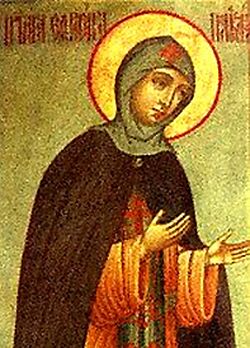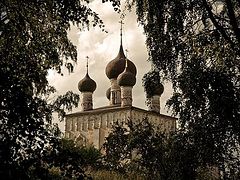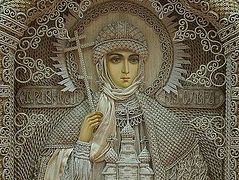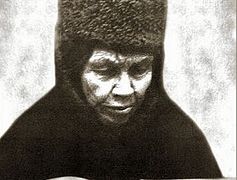Saint Euphrosyne, Abbess of Polotsk, was named Predslava in the world, and was the daughter of Prince George Vseslavich. From her childhood she was noted for her love of prayer and book learning. After turning down a proposal of marriage, Predslava received monastic tonsure with the name Euphrosyne. With the blessing of Bishop Elias of Polotsk, she began to live near the Sophia cathedral, where she occupied herself by the copying of books.
Around the year 1128 Bishop Elias entrusted the nun with the task of organizing a women’s monastery. Setting out for Seltso, the site of the future monastery, the ascetic took only her holy books. At the newly constructed Savior-Transfiguration monastery the saint taught the girls to copy books, singing, sewing and other handicrafts.
Through her efforts, a cathedral was built in 1161, which survives to the present day. St Euphrosyne also founded a men’s monastery dedicated to the Mother of God. Patriarch Luke of Constantinople sent a copy of the wonderworking Ephesus Icon of the Mother of God at her request. Shortly before her death, St Euphrosyne journeyed on pilgrimage to the Holy Places with her nephew David and sister Eupraxia.
After venerating the holy things at Constantinople, she arrived in Jerusalem, where at the Russian monastery of the Most Holy Theotokos the Lord granted her a peaceful end on May 24, 1173.
In 1187 the body of the saint was transferred to the Kiev Caves monastery, and the relics were transferred to Polotsk in 1910 to the monastery she founded.
St Euphrosyne of Polotsk was glorified in the Russian Church as a patroness of women’s monasticism.
The Orthodox Church in America
The tangible spiritual heritage of St. Euphrosyne of Polotsk
St. Euphrosyne of Polotsk, the first Eastern Slavic woman to be canonized by the Orthodox Church, stood at the birth of the tangible representation of a spiritual heritage of universal human values. The masterpieces of architecture, painting, and ornamental arts, in whose creation she was involved, have become tangible assets of the spiritual heritage of the Enlightener herself; furthermore, they exerted an essential impact on the spiritual and cultural development of other countries and nations.
This film was produced by "Zalaty Grad" (Golden City) Publisher, 2009, with financial support from the Vitebsk Regional Executive Committee.




